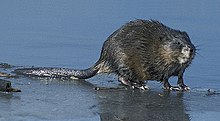| Ondatrini Temporal range: Early Pliocene - present, 4–0 Ma PreꞒ Ꞓ O S D C P T J K Pg N ↓ | |
|---|---|

| |
| Muskrat (Ondatra zibethicus) | |
| Scientific classification | |
| Domain: | Eukaryota |
| Kingdom: | Animalia |
| Phylum: | Chordata |
| Class: | Mammalia |
| Order: | Rodentia |
| Family: | Cricetidae |
| Subfamily: | Arvicolinae |
| Tribe: | Ondatrini Gray, 1825 |
| Genera | |
Ondatrini is a tribe of semiaquatic rodents in the family Arvicolinae. They are known as muskrats. They are related to voles and lemmings.
Classification
It contains two extant species, each in their own genus, both of which are native to North America:
- Genus Neofiber
- Round-tailed muskrat, N. alleni
- Genus Ondatra
- Muskrat, O. zibethicus
Of these, the muskrat (O. zibethicus) is found throughout North America aside from the warmer or drier regions, and has been introduced to Eurasia. The round-tailed muskrat (N. alleni) is only found in Florida and adjacent Georgia, just outside of the range of O. zibethicus. Some authorities place both genera in different tribes (Ondatrini for Ondatra, Neofibrini for Neofiber), but the American Society of Mammalogists places both in Ondatrini, and some molecular evidence supports a close relation between both genera. Some phylogenetic evidence indicates that Balkan snow vole (Dinaromys bogdanovi) may also be a member of the Ondatrini, but this is uncertain and it is still classified in the Pliomyini by the ASM.
Evolution
Ondatrini likely descends from a lineage of Siberian voles that invaded North America about 5 million years ago. The earliest fossils from this tribe are of fossil Ondatra from the early Pliocene. The Pliocene fossil taxa Ogmodontomys and Cosomys, both from North America, are likely also members of this tribe. The Plio-Pleistocene fossil taxa Dolomys, Pliomys (of the tribe Pliomyini) and Kislangia from Eurasia have also been classified in this group by some authorities, but this has been disputed.
A 2021 phylogenetic study found Ondatrini to form the sister group to the Dicrostonychini (defined as including the members of both Dicrostonychini sensu stricto and Phenacomyini).
References
- "Mindat.org". www.mindat.org. Retrieved 2021-12-12.
- Database, Mammal Diversity (2021-11-06), Mammal Diversity Database, doi:10.5281/zenodo.5651212, retrieved 2021-12-12
- ^ "Neofiber alleni F. W. True, 1884". ASM Mammal Diversity Database. American Society of Mammalogists. Retrieved 2021-12-12.
- Modi, William S. (1 May 1996). "Phylogenetic history of LINE-1 among arvicolid rodents". Molecular Biology and Evolution. 13 (5): 633–641. doi:10.1093/oxfordjournals.molbev.a025623. PMID 8676737.

- Robovský, Jan; ŘIčánková, Věra; Zrzavý, Jan (2008). "Phylogeny of Arvicolinae (Mammalia, Cricetidae): utility of morphological and molecular data sets in a recently radiating clade". Zoologica Scripta. 37 (6): 571–590. doi:10.1111/j.1463-6409.2008.00342.x. ISSN 1463-6409. S2CID 86074446.
- ^ Naish, Darren. "A brief history of muskrats". Scientific American Blog Network. Retrieved 2021-12-12.
- Abramson, Natalia I.; Bodrov, Semyon Yu; Bondareva, Olga V.; Genelt-Yanovskiy, Evgeny A.; Petrova, Tatyana V. (2021-11-19). "A mitochondrial genome phylogeny of voles and lemmings (Rodentia: Arvicolinae): Evolutionary and taxonomic implications". PLOS ONE. 16 (11): e0248198. Bibcode:2021PLoSO..1648198A. doi:10.1371/journal.pone.0248198. ISSN 1932-6203. PMC 8604340. PMID 34797834.
| Taxon identifiers | |
|---|---|
| Ondatrini | |